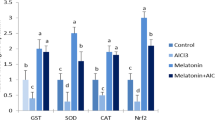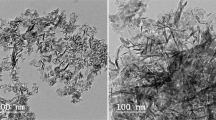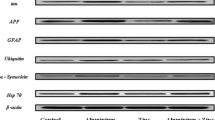Abstract
Aluminum (Al) has been considered as one of the most abundant elements and comprises nearly 8 % of the Earth's crust. Despite of its immense presence, studies regarding the molecular basis of its interaction with the physiological system are rather sparse. On the other hand, zinc (Zn), an essential micronutrient, has been regarded as the second most important metal for brain functioning. The objective of the present study was to investigate the protective potential of Zn, if any, during Al-induced detrimental effects on DNA, tritiated thymidine uptake as well as expression of stress marker genes and proteins in rat brain. Male Sprague–Dawley rats weighing 140–160 g were divided into four different groups viz.: normal control, Al treated (100 mg/kg b wt/day via oral gavage), Zn treated (227 mg/l in drinking water), and combined Al and Zn treated. All the treatments were carried out for a total duration of 8 weeks. Agarose gel electrophoresis revealed DNA laddering pattern and comets in the rat brain following Al treatment, which however, were attenuated upon Zn treatment. Further, terminal deoxynucleotidyl transferase-mediated dUTP nick end labeling (TUNEL)-positive cells, number of apoptotic brain cells, and uptake of tritiated thymidine were increased after Al treatment but were decreased upon Zn supplementation. Western blot and mRNA expressions of p53 and nuclear factor κB (NF-κB) were also found to be significantly elevated after Al treatment, which however, were reversed following Zn treatment. Hence, Zn shall prove to be an effective agent in mitigating the detrimental effects caused by Al in the rat brain.









Similar content being viewed by others
References
Carri MT, Ferri A, Cozzolino M, Calabrese L, Rotilio GV (2003) Neurodegeneration in amyotrophic lateral sclerosis: the role of oxidative stress and altered homeostasis of metals. Brain Res Bull 61:365–374
Bolognin S, Messori L, Zatta P (2009) Metal ion physiopathology in neurode generative disorders. Neuromolecular Med 11:223–238
Rivera-Mancía S, Pérez-Neri I, Ríos C, Tristán-López L, Rivera-Espinosa L, Montes S (2010) The transition metals copper and iron in neurodegenerative diseases. Chem Biol Interact 186:184–199
Garcia T, Esparza JL, Nogués MR, Romeu M, Domingo JL, Gómez M (2010) Oxidative stress status and RNA expression in hippocampus of an animal model of Alzheimer's disease after chronic exposure to aluminum. Hippocampus 20:218–225
Ribes D, Colomina MT, Vicens P, Domingo JL (2010) Impaired spatial learning and unaltered neurogenesis in a transgenic model of Alzheimer's disease after oral aluminum exposure. Curr Alzheimer Res 7:401–408
Walton JR (2010) Evidence for participation of aluminum in neurofibrillary tangle formation and growth in Alzheimer's disease. J Alzheimers Dis 22:65–72
Cooke K, Gould MH (1991) The health effects of aluminium—a review. J R Soc Health 111:163–168
Soni MG, White SM, Flamm WG, Burdock GA (2001) Safety evaluation of dietary aluminum. Regul Toxicol Pharmacol 33:66–79
Yaman M, Güneş M, Bakirdere S (2003) Contamination of aluminium from cooking utensils and yogurt containers. Bull Environ Contam Toxicol 70:437–442
Krewski D, Yokel RA, Nieboer E, Borchelt D, Cohen J, Harry J, Kacew S, Lindsay J, Mahfouz AM, Rondeau V (2007) Human health risk assessment for aluminium, aluminium oxide, and aluminium hydroxide. J Toxicol Environ Health B Crit Rev 10:1–269
Cao H, Qiao L, Zhang H, Chen J (2010) Exposure and risk assessment for aluminium and heavy metals in Puerh tea. Sci Total Environ 408:2777–2784
Kaizer RR, Corrêa MC, Spanevello RM, Morsch VM, Mazzanti CM, Gonçalves JF, Schetinger MR (2005) Acetylcholinesterase activation and enhanced lipid peroxidation after long-term exposure to low levels of aluminum on different mouse brain regions. J Inorg Biochem 99:1865–1870
Kumar V, Bal A, Gill KD (2009) Aluminium-induced oxidative DNA damage recognition and cell-cycle disruption in different regions of rat brain. Toxicology 264:137–144
Sumathi T, Shobana C, Kumari BR, Nandhini DN (2011) Protective role of Cynodon dactylon in ameliorating the aluminium-induced neurotoxicity in rat brain regions. Biol Trace Elem Res 144:843–853
Moumen R, Ait-Oukhatar N, Bureau F, Fleury C, Bouglé D, Arhan P, Neuville D, Viader F (2001) Aluminium increases xanthine oxidase activity and disturbs antioxidant status in the rat. J Trace Elem Med Biol 15:89–93
Rui D, Yongjian Y (2010) Aluminum chloride induced oxidative damage on cells derived from hippocampus and cortex of ICR mice. Brain Res 1324:96–102
Yellamma K, Saraswathamma S, Kumari BN (2010) Cholinergic system under aluminium toxicity in rat brain. Toxicol Int 17:106–112
Singla N, Dhawan DK (2012) Regulatory role of zinc during aluminium-induced altered carbohydrate metabolism in rat brain. J Neurosci Res 90:698–705
Swegert CV, Dave KR, Katyare SS (1999) Effect of aluminium-induced Alzheimer like condition on oxidative energy metabolism in rat liver, brain and heart mitochondria. Mech Ageing Dev 112:27–42
Niu PY, Niu Q, Zhang QL, Wang LP, He SE, Wu TC, Conti P, Di Gioacchino M, Boscolo P (2005) Aluminum impairs rat neural cell mitochondria in vitro. Int J Immunopathol Pharmacol 18:683–689
Ghribi O, Herman MM, DeWitt DA, Forbes MS, Savory J (2001) Abeta (1-42) and aluminum induce stress in the endoplasmic reticulum in rabbit hippocampus, involving nuclear translocation of gadd 153 and NF-kappa B. Brain Res Mol Brain Res 96:30–38
Yang SJ, Lee JE, Lee KH, Huh JW, Choi SY, Cho SW (2004) Opposed regulation of aluminum-induced apoptosis by glial cell line-derived neurotrophic factor and brain-derived neurotrophic factor in rat brains. Brain Res Mol Brain Res 127:146–149
Walton JR (2012) Aluminum disruption of calcium homeostasis and signal transduction resembles change that occurs in aging and Alzheimer's disease. J Alzheimers Dis 29:255–273
Stefanidou M, Maravelias C, Dona A, Spiliopoulou C (2006) Zinc: a multipurpose trace element. Arch Toxicol 80:1–9
Chasapis CT, Loutsidou AC, Spiliopoulou CA, Stefanidou ME (2012) Zinc and human health: an update. Arch Toxicol 86:521–534
An WL, Pei JJ, Nishimura T, Winblad B, Cowburn RF (2005) Zinc-induced anti-apoptotic effects in SH-SY5Y neuroblastoma cells via the extracellular signal-regulated kinase 1/2. Brain Res Mol Brain Res 135:40–47
Kahmann L, Uciechowski P, Warmuth S, Plümäkers B, Gressner AM, Malavolta M, Mocchegiani E, Rink L (2008) Zinc supplementation in the elderly reduces spontaneous inflammatory cytokine release and restores T cell functions. Rejuvenation Res 11:227–237
Sowa-Kucma M, Legutko B, Szewczyk B, Novak K, Znojek P, Poleszak E, Papp M, Pilc A, Nowak G (2008) Antidepressant-like activity of zinc: further behavioral and molecular evidence. J Neural Transm 115:1621–1628
Pavlica S, Gebhardt R (2010) Comparison of uptake and neuroprotective potential of seven zinc-salts. Neurochem Int 56:84–93
Joshi D, Mittal DK, Shukla S, Srivastav AK (2012) Therapeutic potential of N acetyl cysteine with antioxidants (Zn and Se) supplementation against dimethylmercury toxicity in male albino rats. Exp Toxicol Pathol 64:103–108
Gower-Winter SD, Levenson CW (2012) Zinc in the central nervous system: from molecules to behavior. Biofactors 38:186–193
Rudolf E, Cervinka M (2006) The role of intracellular zinc in chromium(VI)-induced oxidative stress, DNA damage and apoptosis. Chem Biol Interact 162:212–227
Bhalla P, Chadha VD, Dhawan DK (2007) Effectiveness of zinc in modulating lithium induced biochemical and behavioral changes in rat brain. Cell Mol Neurobiol 27:595–607
Takeda A (2001) Zinc homeostasis and functions of zinc in the brain. Biometals 14:343–351
Bitanihirwe BK, Cunningham MG (2009) Zinc: the brain's dark horse. Synapse 63:1029–1049
Liu J, Jiang Y, Huang C, Fang H, Fang H, Pang W (2010) Proteomic analysis reveals changes in the hippocampus protein pattern of rats exposed to dietary zinc deficiency. Electrophoresis 31:1302–1310
Suzuki H, Asakawa A, Li JB, Tsai M, Amitani H, Ohinata K, Komai M, Inui A (2011) Zinc as an appetite stimulator—the possible role of zinc in the progression of diseases such as cachexia and sarcopenia. Recent Pat Food Nutr Agric 3:226–231
Sindreu C, Storm DR (2011) Modulation of neuronal signal transduction and memory formation by synaptic zinc. Front Behav Neurosci 5:68
Toth K (2011) Zinc in neurotransmission. Annu Rev Nutr 31:139–153
Bhalla P, Singla N, Dhawan DK (2010) Potential of lithium to reduce aluminium-induced cytotoxic effects in rat brain. Biometals 23:197–206
Goel A, Dhawan DK (2001) Zinc supplementation prevents liver injury in chlorpyrifos-treated rats. Biol Trace Elem Res 82:185–200
Weiss S, Cataltepe O, Cole AJ (1996) Anatomical studies of DNA fragmentation in rat brain after systemic kainate administration. Neuroscience 74:541–551
Singh NP, Mccoy MT, Tice RR, Schneider ELA (1988) Single technique for quantitation of low levels of DNA damage in individual cells. Exp Cell Res 175:184–191
Nikodemova M, Watters JJ (2011) Outbred ICR/CD1 mice display more severe neuro inflammation mediated by microglial TLR4/CD14 activation than inbred C57Bl/6 mice. Neuroscience 190:67–74
Crane R, Madelstam P (1960) The active transport of sugars by various preparation of hamster intestine. Biochim Biophys Acta 45:460–464
Towbin H, Staehelin T, Gordon J (1992) Electrophoretic transfer of proteins from polyacrylamide gels to nitrocellulose sheets: procedure and some applications. Biotechnology 24:145–149
Lowry OH, Rosebrough NJ, Farr AL, Randall RJ (1951) Protein measurement with the Follin-phenol reagent. J Biol Chem 193:265–275
Shrivastava S (2012) Combined effect of HEDTA and selenium against aluminum induced oxidative stress in rat brain. J Trace Elem Med Biol 26:210–214
Karlik SJ, Eichhorn GL, Lewis PN, Crapper DR (1980) Interaction of aluminum species with deoxyribonucleic acid. Biochemistry 19:5991–5998
Zhang RY, Liu Y, Pang DW, Cai RX, Qi YP (2002) Spectroscopic and voltammetric study on the binding of aluminium(III) to DNA. Anal Sci 18:761–766
Moselhy WA, Helmy NA, Abdel-Halim BR, Nabil TM, Abdel-Hamid MI (2012) Role of ginger against the reproductive toxicity of aluminium chloride in albino male rats. Reprod Domest Anim 47:335–343
Savory J, Rao JK, Huang Y, Letada PR, Herman MM (1999) Age-related hippocampal changes in Bcl-2:Bax ratio, oxidative stress, redox-active iron and apoptosis associated with aluminum-induced neurodegeneration: increased susceptibility with aging. Neurotoxicology 20:805–817
Tuneva J, Chittur S, Boldyrev AA, Birman I, Carpenter DO (2006) Cerebellar granule cell death induced by aluminum. Neurotox Res 9:297–304
Zago MP, Mackenzie GG, Adamo AM, Keen CL, Oteiza PI (2005) Differential modulation of MAP kinases by zinc deficiency in IMR-32 cells: role of H2O2. Antioxid Redox Signal 7:1773–1782
Takeda A, Tamano H, Ibuki Y (2004) Change of zinc uptake under growth arrest and apoptosis. Anticancer Res 24:3869–3874
Corniola RS, Tassabehji NM, Hare J, Sharma G, Levenson CW (2008) Zinc deficiency impairs neuronal precursor cell proliferation and induces apoptosis via p53-mediated mechanisms. Brain Res 1237:52–61
Adamo AM, Zago MP, Mackenzie GG, Aimo L, Keen CL, Keenan A, Oteiza PI (2010) The role of zinc in the modulation of neuronal proliferation and apoptosis. Neurotox Res 17:1–14
Niu Q, Yang Y, Zhang Q, Niu P, He S, Di Gioacchino M, Conti P, Boscolo P (2007) The relationship between Bcl-gene expression and learning and memory impairment in chronic aluminum-exposed rats. Neurotox Res 12:163–169
Johnson VJ, Kim SH, Sharma RP (2005) Aluminum-maltolate induces apoptosis and necrosis in neuro-2a cells: potential role for p53 signaling. Toxicol Sci 83:329–339
Pan R, Qiu S, Lu DX, Dong J (2008) Curcumin improves learning and memory ability and its neuroprotective mechanism in mice. Chin Med J (Engl) 121:832–839
Duffy JY, Miller CM, Rutschilling GL, Ridder GM, Clegg MS, Keen CL, Daston GP (2001) A decrease in intracellular zinc levels precedes the detection of early indicators of apoptosis in HL-60 cells. Apoptosis 6:161–172
Latha KS, Anitha S, Rao KS, Viswamitra MA (2002) Molecular understanding of aluminum-induced topological changes in (CCG)12 triplet repeats: relevance to neurological disorders. Biochim Biophys Acta 1588:56–64
Lankoff A, Banasik A, Duma A, Ochniak E, Lisowska H, Kuszewski T, Góźdź S, Wojcik A (2006) A comet assay study reveals that aluminium induces DNA damage and inhibits the repair of radiation-induced lesions in human peripheral blood lymphocytes. Toxicol Lett 161:27–36
Duan J, Nilsson L (2006) Effect of Zn2+ on DNA recognition and stability of the p53 DNA-binding domain. Biochemistry 45:7483–7492
Lukiw WJ, Percy ME, Kruck TP (2005) Nanomolar aluminum induces pro-inflammatory and pro-apoptotic gene expression in human brain cells in primary culture. J Inorg Biochem 99:1895–1898
Aimo L, Mackenzie GG, Keenan AH, Oteiza PI (2010) Gestational zinc deficiency affects the regulation of transcription factors AP-1, NF-κB and NFAT in fetal brain. J Nutr Biochem 21:1069–1075
Acknowledgments
We are grateful to the University Grants Commission (UGC), New Delhi, India and the Department of Science and Technology (DST-INSPIRE), New Delhi, India for financial support.
Conflict of interest
None.
Author information
Authors and Affiliations
Corresponding author
Rights and permissions
About this article
Cite this article
Singla, N., Dhawan, D.K. Zinc, a Neuroprotective Agent Against Aluminum-induced Oxidative DNA Injury. Mol Neurobiol 48, 1–12 (2013). https://doi.org/10.1007/s12035-013-8417-7
Received:
Accepted:
Published:
Issue Date:
DOI: https://doi.org/10.1007/s12035-013-8417-7




